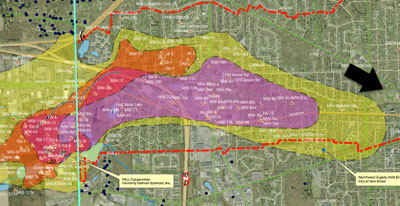Ann Arbor city council meeting (Oct. 3, 2011): In spite of the eight public hearings scheduled for Monday night, the council’s agenda was actually relatively light. Six of the public hearings were very similar requests for annexations of property from Scio Township into the city of Ann Arbor. The annexations were all approved with scant comment from the public or the council.

Stephen Kunselman (Ward 3) and Carsten Hohnke (Ward 5) talk before the start of the Oct. 3 council meeting. (Photos by the writer)
But two agenda items – both related to the future of the block of South Fifth Avenue just south of William – resulted in over an hour of deliberations by the council.
An item added late Monday afternoon gave a glimmer of hope to the Heritage Row planned unit development (PUD), which the council last had on its agenda on Dec. 6, 2010 – nearly a year ago. On Monday, the council voted to suspend its rules, then voted to reconsider the project, and finally voted to postpone it until its Oct. 17 meeting.
By Oct. 17, a set of changes proposed by the development team are to be incorporated into the site plan and zoning regulations for Heritage Row. The developer says the changes to Heritage Row would be necessary, in order for him to diverge from his current intention to build City Place, an already approved “matter of right” project at the same location. Those changes include eliminating any on-site parking requirement, increasing the number of residents, relaxing the energy standards, and not making a commitment to the historical preservation of the existing seven houses on the site. [.pdf of letter from developer]
If the council were to give the new version of Heritage Row initial approval at its Oct. 17 meeting, it would then take a second and final vote on it at a meeting now scheduled for Oct. 24.
In a related action, the council approved a revision to the development agreement for City Place that eliminated the need for the developer to complete off-site utility work before being issued a building permit for that project. Now, that utility work would need to be completed later in the process, before the certificate of occupancy is issued. The relaxation of the timeline was undertaken to allow the developer additional flexibility to discuss a modified Heritage Row, as an alternative to City Place.
In other business, the council again delayed action on a resolution of intent for the use of revenue generated by a proposed street and sidewalk repair millage that voters will be asked to approve at the Nov. 8 election. Questions concerned the need for such a resolution at all, as well as the plan for use of the millage inside the Ann Arbor Downtown Development Authority district.
A request for rezoning a medical marijuana business on South State Street was denied by the council, but did achieve three votes on the 11-member body.
The council also approved an easement for DTE to replace a gas main along the north side of Fuller Road. [Full Story]
 Map of Pall-Gelman 1,4-dioxane plume, by Washtenaw County. Black arrow added to indicate baseball field at West Park. The yellow region is the estimated plume … [Full Story]
Map of Pall-Gelman 1,4-dioxane plume, by Washtenaw County. Black arrow added to indicate baseball field at West Park. The yellow region is the estimated plume … [Full Story]





